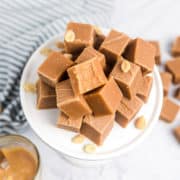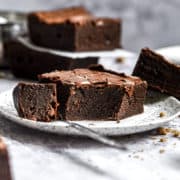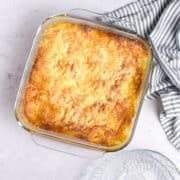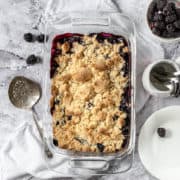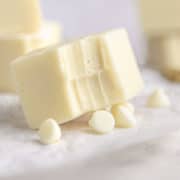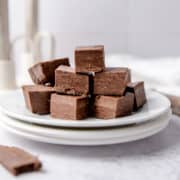Cabbage is popular all over the world and is used in plenty of different recipes and cuisines. When you know how to store fresh cabbage, you will be able to make sure it stays fresh for as long as possible.

Jump to:
This popular vegetable can be eaten raw or cooked. It makes a tasty side dish and can be used in all kinds of recipes from stir fries to salads. Shredded raw red cabbage makes a great topping for tacos, while green cabbage can be flavored with spices and sauteed as a flavor-packed side dish.
I often pick up a head of cabbage from the grocery store because it's an economical choice and there are so many recipes to use it in, including cabbage rolls (a family favorite!) as well as salads.
What is Cabbage?
Cabbage (Brassica Oleracea) is related to Brussels sprouts, broccoli, kale, and cauliflower. It's a vegetable that comes in various colors, textures, shapes, and sizes. Some types are better for salads while others are better cooked.
The most common kind of cabbage is the white cabbage which is available from most grocery stores. Also known as cannonball cabbage, this variety is round and pale green fading to white at the core. The outer leaves are dark green when harvested from the field. White cabbage is chewy and slightly bitter when raw but sweet and aromatic when cooked.
Another popular variety is the savoy cabbage which is loose-leafed and round in shape. The leaves are wrinkled and stay firm after cooking. This costs more than white cabbage because it's more challenging to grow, but does offer plenty of important nutrients like Vitamins A, B6, C, and K, as well as fiber, potassium, magnesium, calcium, and folate.
Red cabbage is named for its color and can be shredded to add crunch to a salad or cooked or pickled. The leaves can be deep red or purple depending on the pH of the soil it grows in.
Cabbages have been grown for more than 4,000 years, although Brussels sprouts (in the cabbage family) have only been around for 500 years.
How to Buy the Best Cabbage
Whether you're shopping for a green, red, or purple cabbage, make sure it's a bright color and not faded, since that's an indication of freshness.
It should be firm rather than spongy or soft (which might mean it's spoiled inside) and the leaves should be crisp. Choose a cabbage that only has a couple of leaves hanging off rather than an older one that seems loose all over.
The bigger the cabbage, the milder the taste so, if you're not used to eating this vegetable or you aren't so keen, choose a bigger one. Perhaps you're a keen home gardener yourself and want to try growing your own.
Also, it's useful to know that weather conditions can affect a cabbage's flavor. Cabbages picked after a frost are going to be sweeter than those picked before it, so you can ask the seller about that if you're purchasing from a farmers' market.

How to Store Cabbage
Once you know the best storage method for this versatile vegetable, you might find yourself using it in more recipes, perhaps also trying different types of cabbage or preparing it in different styles.
- Don't cut or chop your raw cabbage until you're ready to use it. Not only does that speed up spoilage but it also reduces the Vitamin C content.
- Keep the cabbage in a plastic bag in the crisper drawer of your refrigerator, as the cold keeps it crisp and preserves the nutrients.
- If there isn't enough space, keep it at a cool temperature, such as in an unheated basement, root cellar, or similar, with a low room temperature.
- If you are storing cut cabbage, cabbage wedges, or shredded cabbage, wrap it tightly in plastic wrap or use Ziploc bags or an airtight container and use it within 2 days for the best results.
- Cooked cabbage will keep for a few days in an airtight container in the refrigerator.
Most types of whole cabbage heads have a shelf life of about 2 weeks in the refrigerator. This doesn't apply to savoy cabbage. Savoy cabbages don't keep for as long as tight-leafed varieties because more moisture can get into them so use it within one week.
Cabbages can be frozen whole or chopped. I like to chop mine first so I don't have to thaw more than I need. Because cabbages are only harvested in the fall, the ones you spot on grocery store shelves were probably picked months ago, so stock up in the fall and freeze them.
To freeze cabbage, remove the outer leaves and chop up the remainder with a sharp knife. Blanch it in boiling water for 2 minutes then plunge into ice water or cold water. Dry the cabbage well and flash freeze it on a cookie sheet, before transferring it into freezer bags for long-term storage.
How to Spot a Spoiled Cabbage
Bad cabbage might be yellow, brown, or black. You might see wetness in the package from moisture loss, or shriveled, withering leaves, neither of which is a good sign. A rotten cabbage might have a bad smell or be slimy and mushy. The less crisp the leaves, the older the cabbage, so choose something bright-colored with crisp leaves for the tastiest result.
Common Questions
Because there are so many types of cabbage, there are various seasons for different types. Bok choy, Chinese leaf, and Hispi cabbage are in season in the spring and summer, red cabbage is best over the winter and then savoy cabbage followed by spring greens take you into the spring. So, you should be able to find this cruciferous vegetable throughout the year.
Most types of cabbage just have to be shredded and then briefly blanched, steamed, or stir-fried. Other varieties are better for pickling, fermenting, or serving raw in salads.
The best way to serve this humble vegetable is al dente, so it still has a little bit of crunch. White or green cabbage only needs to be cooked for around 4 minutes, while red cabbage is best braised, boiled, or steamed for longer, and then you can also fry it in a little oil if you like.
Pickled red cabbage is really delicious and kimchi is an Asian fermented cabbage dish. Cabbage can also be used in place of tortillas or bread, or used instead of dumpling wrappers, as a great way to add a new twist to a classic dish, as well as make it healthier.

Fun Facts
- Cabbage is the national food of Russia and Russians eat about 7 times as much cabbage as Americans.
- The ancient Romans and Greeks grew about 10 cabbage varieties. In the 1800s there were 30 varieties, and today there are more than 100 types of cabbage.
- Red cabbage can be used to make a natural red dye for fabric or food.
Now you know how to store a whole head of cabbage or chopped cabbage, or how to freeze it, you might like to experiment with your own cabbage recipes and come up with some new, healthy ways to enjoy this mild yet versatile vegetable.





